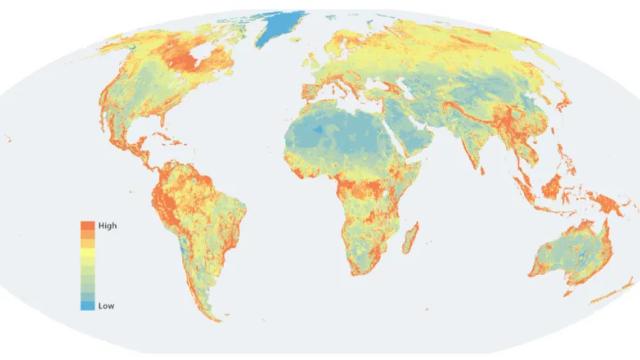Nature Map – a new tool to support countries to integrate nature and climate in policymaking and promote nature-based solutions
Countries need integrated maps of biodiversity and ecosystem services, including carbon storage, to design and implement national policies for halting and reversing the loss of biodiversity and for curbing net greenhouse gas emissions from land use. Yet, such maps are in short supply. A recent SDSN review shows that national climate strategies do not integrate maps even though they are necessary to promote nature-based solutions.
Nature Map releases new global maps to support environmental decision-making.
To help fill the gap, Nature Map offers freely available global maps of terrestrial biodiversity, carbon stocks and water supply, designed to support governments in policy design. These maps are brought together to give an integrated view of the importance of different areas for all of these assets. Another map identifies areas where ecosystem restoration can enhance them. Such maps are needed to support (i) agreement on bold and operational biodiversity objectives; (ii) effective monitoring and verification, (iii) integrated strategies that tackle the drivers of biodiversity loss and climate change, including land-use change; (iv) the greening of supply chains for agricultural and forestry products; and (v) carbon markets for nature-based solutions. Thus, they can play a critical role in making next year’s COP26 of the climate convention and COP15 under the biodiversity convention a success.
Says Neil Burgess, Chief Scientist at UNEP-WCMC: “ Nature Map is a crucial new tool that can help to guide policies that tackle the twin crises of climate change and biodiversity loss together. We have combined the best available data on global patterns and priorities for biodiversity, carbon and water, and this data is now freely available for decision making both globally and nationally to support integrated policy commitments”.
The Nature Map approach can be applied at the national level
Nature Map’s methods have already been applied by Fundación Bariloche and partners in Argentina . Other national applications are underway and planned in Colombia, India, Indonesia, and Mexico. They seek to promote integrated strategies for climate and biodiversity and to support spatial planning as called for in the zero draft of the post-2020 Global Biodiversity Framework. Nature Map helps countries integrate the best available data and enhance complementarities between their national climate and biodiversity strategies, including Nationally Determined Contributions (NDCs) and Nationally Biodiversity Strategies and Action Plans (NBSAPs).
Says Guido Schmidt-Traub, Executive Director of the SDSN, “I am very impressed with the initial application of Nature Map methods and data in Argentina. Every country needs to include maps of conservation and restoration priorities in its climate and biodiversity strategies. This will be a powerful way to promote integrated strategies that tackle nature and climate.”
Nature Map looking forward
To inform UNFCCC COP26, Nature Map is currently assessing the role that achieving biodiversity conservation targets can play in securing emissions reductions needed to meet the objectives of the Paris Agreement. This information is expected to enable policy leaders in both climate and biodiversity to position nature more centrally in the climate agenda. In future, satellite data on land-use change can be combined with Nature Map to assess how biodiversity, carbon storage, and other ecosystem services change over time and to track progress towards meeting the objectives of the CBD and the UNFCCC.
Areas of global importance for terrestrial biodiversity and carbon
The data are available in UN Biodiversity Lab , an online platform developed by UNDP and UNEP to provide high quality data for government representatives to provide key information on the Aichi Biodiversity Targets and nature-based Sustainable Development Goals.
Areas of global significance for the restoration of biodiversity and carbon storage
Nature Map is led by the International Institute for Applied Systems Analysis (IIASA), International Institute for Sustainability (IIS) Rio, UN Environment Programme World Conservation Monitoring Centre (UNEP-WCMC), and the UN Sustainable Development Solutions Network (SDSN). Royal Botanic Gardens Kew, and many other scientific partners support this initiative.
Nature Map gratefully acknowledges financial support from Norway’s International Climate and Forest Initiative (NICFI).
--
More information about Nature Map: www.naturemap.earth
Contact us at: [email protected]
Researcher contacts:
Piero Visconti
IIASA
[email protected]
Neil Burgess
UNEP-WCMC
[email protected]
Guido Schmidt-Traub
SDSN
[email protected]
Media contacts:
Ansa Heyl (Vienna)
IIASA
Tel: +43 2236 807 574
Haf Davies (Cambridge UK)
UNEP-WCMC
Tel: +447952 920 159
Cheyenne Maddox (New York)
SDSN
Tel: +1 270 978 1955
[email protected]

